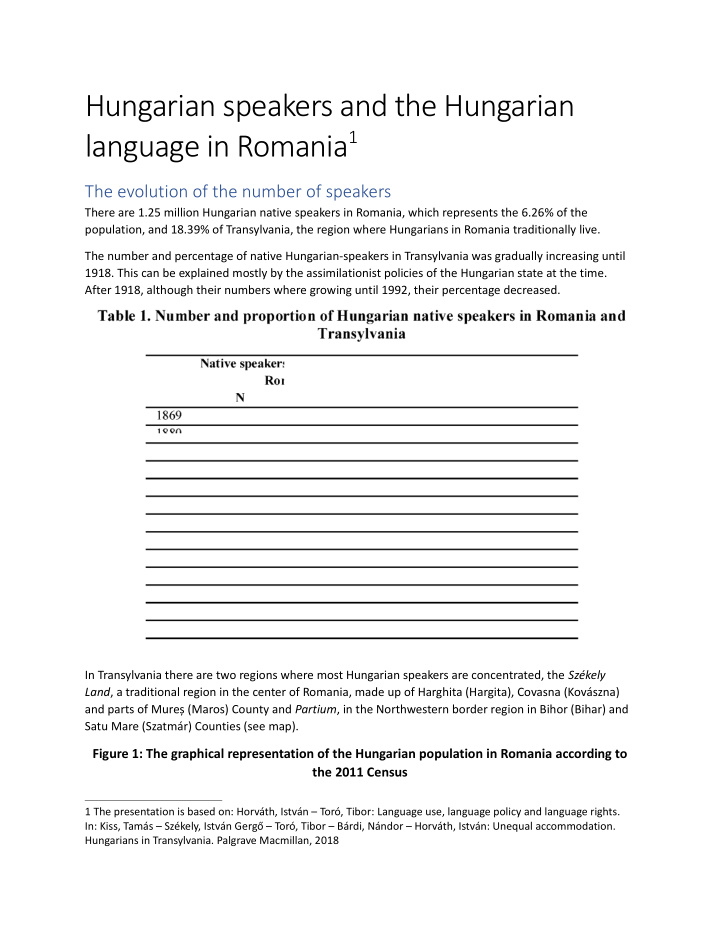



Hungarian speakers and the Hungarian language in Romania 1 The evolution of the number of speakers There are 1.25 million Hungarian native speakers in Romania, which represents the 6.26% of the population, and 18.39% of Transylvania, the region where Hungarians in Romania traditionally live. The number and percentage of native Hungarian-speakers in Transylvania was gradually increasing until 1918. This can be explained mostly by the assimilationist policies of the Hungarian state at the time. After 1918, although their numbers where growing until 1992, their percentage decreased. In Transylvania there are two regions where most Hungarian speakers are concentrated, the Székely Land , a traditional region in the center of Romania, made up of Harghita (Hargita), Covasna (Kovászna) and parts of Mureș (Maros) County and Partium , in the Northwestern border region in Bihor (Bihar) and Satu Mare (Szatmár) Counties (see map). Figure 1: The graphical representation of the Hungarian population in Romania according to the 2011 Census 1 The presentation is based on: Horváth, István – Toró, Tibor: Language use, language policy and language rights. In: Kiss, Tamás – Székely, István Gergő – Toró, Tibor – Bárdi, Nándor – Horváth, István: Unequal accommodation. Hungarians in Transylvania. Palgrave Macmillan, 2018
source: https://ro.wikipedia.org/wiki/Maghiarii_din_Rom%C3%A2nia Minority language skill among dominant language speakers Most Hungarian native speakers (more than 97%) also identify themselves as ethnic Hungarian, meaning that language is an important boundary constructing element between the Romanian majority and the Hungarian minority. The Hungarian language skill of the non-Hungarians is low, only a negligible proportion (around 1.5%) of the non-Hungarian population in Romania speaks Hungarian. This means that non-Hungarians are not interested to learning the language, and that Hungarian as a foreign language is not perceived as an asset by non-Hungarians in the labor market. Patterns of language use in different domains According to István Horváth around 1) 25% of Hungarians are monolingual Hungarians, who use almost only Hungarian in all domains, 2) 40-45% are unassimilated bilinguals, who use Hungarian in their private domain, but in official domains they use Romanian to some extent, 3) around 20% are assimilated bilinguals, who use both languages in their private domains and use almost exclusively Romanian in their official encounters and 4) around 10% are fully assimilated, who use Romanian regularly or exclusively in every domain of life. In their case language change seems imminent.
Language use and employability There are around 200 municipalities where Hungarians live in a majority, however there is no data on the language proficiency of Romanians in these settlements. More than half of Hungarian speakers live in these settlements and one third of them live in municipalities, where they are in dominant position (see Table 2). In these cases, Hungarian language is dominantly used in all domains of daily life. In other words, the knowledge of Hungarian in these cases represents an asset on the labor market. However, the settlements with this kind of Hungarian representation represent only 17% of the 1181 settlements where Hungarians live. Also, none of the major cities in Romania has a Hungarian majority, as the largest urban settlement where Hungarians make up the majority is Sfântu Gheorghe (Sepsiszentgyörgy), with approximately 54,000 inhabitants. Although most non-Hungarians do not speak Hungarian, the need for Hungarian language proficiency among non-Hungarians could be legitimated by several researches. First, according to a research conducted by the Igen tessék! (Yes, please) movement, an organization which promotes Hungarian language use in business in Cluj/Kolozsvár, most Hungarians, even if they have a good Romanian language proficiency would prefer Hungarian language services in all domains (see Figure 3).
source: Igen, tessék (2016) These findings are extremely important, because in Cluj/Kolozsvár only 16% of the population is Hungarians, therefore the use of Hungarian is less possible than in settlements with Hungarian majority. Also, they had shown that half of Hungarians, if they need to choose between a service that is offered in Hungarian and one that is offered in Romanian, would choose the former one. 2 Similar findings are articulated by sociologist Zsombor Csata, who argues that a growing number of Hungarian language speakers look for jobs where the linguistic environment is Hungarian and Hungarian entrepreneurs and company owners look for Hungarian speaking workforce. In other words, the knowledge of Hungarian language in regions were Hungarian is dominant would be an asset for the whole population. 3 2 See Talpas, Botond – Bethlendi, András: Igen, tessék. Korunk, 2016 május. 3 Csata, Zsombor: Economy and ethnicty in Tranyslvania. In: Kiss, Tamás – Székely, István Gergő – Toró, Tibor – Bárdi, Nándor – Horváth, István: Unequal accommodation. Hungarians in Transylvania. Palgrave Macmillan, 2018
Recommend
More recommend